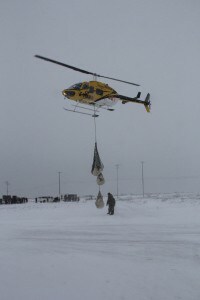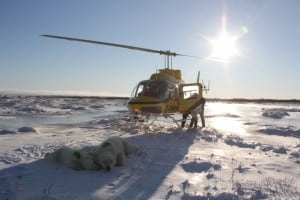Share this article
Managing Human-Wildlife Conflict in the Polar Bear Capital
For most of the world, polar bears are beautiful and fascinating creatures more likely to be seen on the cover of a magazine. But the raw size of one of the largest land predators in the Americas takes on a different light when it’s sitting on your front driveway.
This occurrence may seem unlikely for most of the world, but it’s a very real possibility in Churchill, Manitoba — the so-called polar bear capital of the world. In this small village that sits on Canada’s western Hudson Bay, wildlife managers work 24 hours a day to try to lower the likelihood of conflicts between humans and polar bears. To get an idea of what this job entails, The Wildlife Society spoke to Brett Wlock, a natural resource officer with the Manitoba Conservation and Water Stewardship agency and the head of the Polar Bear Alert Program in Churchill.
A Job Description
For Wlock, public safety is number one and “polar bears roaming around pose a significant danger to public safety.” When a bear wanders into town, wildlife managers first try hazing techniques to chase off the bear. “Most of the time it’s as easy as driving the truck towards the bear and honking the horn,” Wlock said. Sometimes they fire projectiles from shotguns called cracker shells, or bear bangers, to scare them away. “It’s more of a loud noise than a flash or a firework.”
Some bears realize it won’t hurt them and, in rare cases, Wlock’s team uses rubber bullets to scare them away. In other cases, flying a helicopter over the bear may frighten it off.
Repeat Offenders
Some bears just don’t get the message, however. Some get used to the garbage they find in certain areas and can be removed by setting traps in those areas. “Once a bear has found garbage and made a meal, it’s pretty much impossible to prevent them,” Wlock said.
Other bears wise up to the traps and become “repeat offenders.”
“Every year they come back and do the same thing, whether breaking into a garbage can or hanging around a waste transfer station [essentially an indoor garbage dump]. Those are the bears that we are looking for and trying to keep away from people. We’d prefer to see a bear that veers away from people.”
Some of these “repeat offenders” are well known, though they are best identified by a tattoo on their lip and a number on their ear than some kind of wanted poster with a mugshot.

Some polar bears are lifted outside the city to reduce the probability of human-wildlife conflicts. Image courtesy of Province of Manitoba
One 17-year-old male breaks into a building and trashes everything in sight every single time it comes into town. Others, such as one that came through town in early September, have “a large rap sheep of garbage-related incidents.” The latter bear seemed unperturbed by the three traps set for it and so biologists had to tranquilize it from a helicopter. “The terrain around here is very inaccessible with a lot of marsh, trees, rocks, hills and cliffs. A helicopter is the only way to go. The safety of our staff is also very important,” he said.
Jail Time for Bad Bears
Some of the tranquilized bears are flown outside of town via helicopter and set free. But some are taken to a holding facility —a kind of jail for delinquent bears. The facility is just a holding place rather than some kind of a behavior correction facility, but repeat offenders tend to spend more time in the 28-cell facility in town. “What they did in the first place will determine how long they will stay there. A bear that is an incidental capture will not stay as long as a bear that has a history of damaging property or risk to people,” Wlock said. Light offenders, or incidental catches, are released far from the city earlier on, while the repeat offenders are released once the ice begins to freeze enough in the bay. Once there is enough ice, even the worst offenders will be keener to search for seals than feed on garbage or someone’s poodle.
On Managing Human Behavior
“A huge part of our job here is managing people. Making sure people aren’t doing stuff that’s going to affect bears in a negative way,” Wlock said. Part of this is making sure that people don’t litter and keeping tourists from feeding the bears. Bears, after all, are very opportunistic. “If they can find a good free meal they’ll do it. Bears will be bears.”
Header Image: A polar bear trap.
Image courtesy of Province of Manitoba









